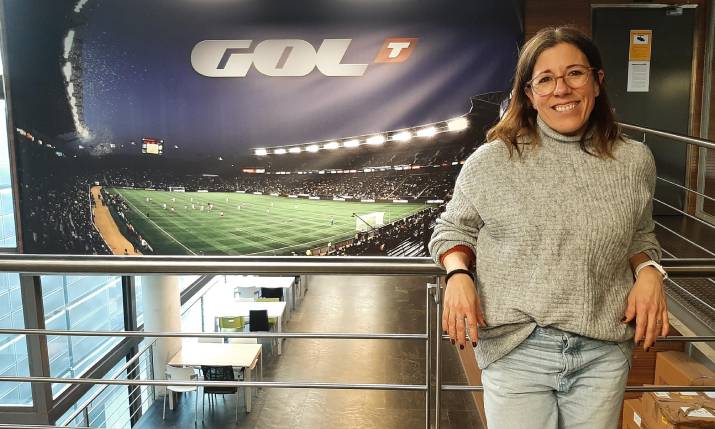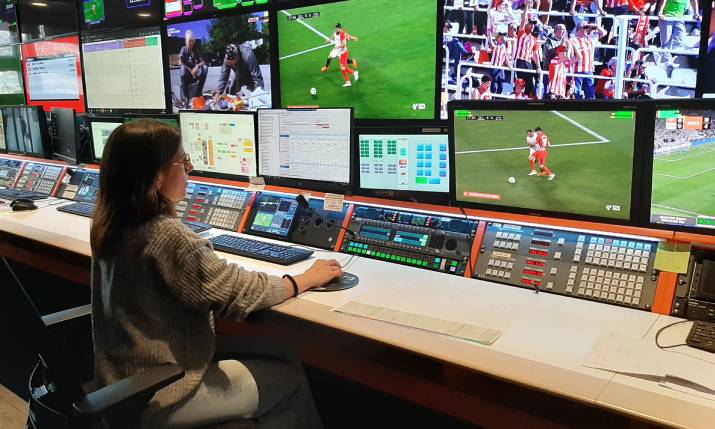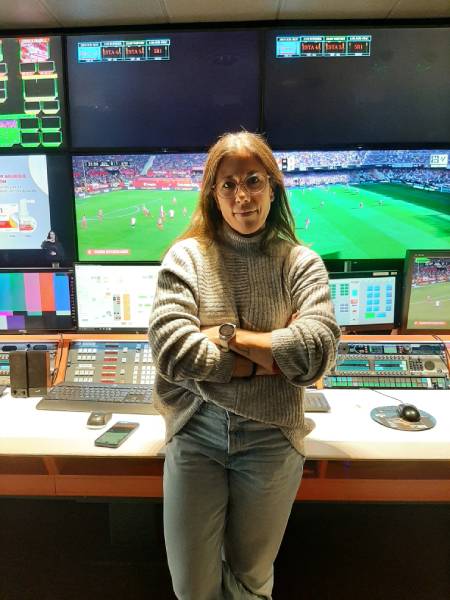Ingenious expectations: Finding a way around obstacles with Mediapro’s technical director Silvia Roy

Silvia Roy is technical director of Grup Mediapro’s sports production hub in Barcelona, Spain
Silvia Roy, technical director of Grup Mediapro’s sports production hub in Barcelona, Spain, likes to find a way around obstacles in order to meet her clients’ expectations. She says, “all this gives you an adrenaline rush that’s really quite addictive”. Here we talk to Roy about her career path and what she loves about her work today.
What drew you to your career in the field of live sport?
In general, what attracts me most about my work is that we have to be very ingenious in order to meet our clients’ needs. Often they ask for things without taking into account the technical limits, but when you manage to find a way around the obstacles you encounter and come up with a good solution for what the client wants, it’s incredibly satisfying. Being able to say, “don’t worry, we’ll find a way to make it happen,” is awesome!
It’s also very exciting when you are at a live event where all kinds of unforeseen circumstances can arise and you have to make quick decisions to address problems. All this gives you an adrenaline rush that’s really quite addictive.
I enjoy the continuous challenges that our sector brings each day, like when a new project arrives and we have to implement it, or when we have to find the most effective and sustainable way to carry out a project, or when we have to create a new workflow because a client asks us for something unusual. I even enjoy the days and nights when there’s some kind of incident and I have to find a solution urgently. The thing is that when you are doing something you like, you enjoy every step along the way.

Silvia Roy working hard on a LaLiga match
What made you first consider TV broadcasting as a career? What sparked your interest, and why sports broadcasting?
I would say that it wasn’t so much that I chose it, but that the opportunity presented itself. Grup Mediapro acquired the broadcast rights to Spanish football’s LaLiga and set up a big production centre in Barcelona and GolTV. At that time, I was working as a tech director at several channels, and I also took on the latter.
After years working on various Mediapro projects, they offered me the chance to head up this area and I couldn’t say no. It was a very interesting opportunity – a quantum leap and a new role in which I could continue my professional growth.
“I believe that we women who are in a profession where the majority of people are men tend to be more demanding of ourselves. I can’t say why, but I think what was hardest for me was to believe in myself and feel confident of my ability to do my job well”
It was an opportunity for professional growth. A chance to keep learning and to create workflows allowing us to do the job more efficiently. It was quite a challenge and I found that very attractive.
Clients like LaLiga have very high expectations and every year there are new challenges to meet within very tight timeframes. This means our work is never monotonous and that we must always be learning and upskilling. For me, this was a plus when it came to accepting the job.
Then came the launch of beIN Sports France and since my return to Barcelona, I’ve been back in the production centre as tech director.
How has your career path unfolded within the TV industry?
I started doing some occasional work while studying. When I finished my degree, I started working at Mediapro as playout supervisor for some of the group’s channels (FlaixTV, 8TV, etc.).
In 2006, after being part of the production team for the Basketball World Championship in Japan, I was appointed tech director of several channels, particularly in the sports arena. In 2012, I participated in the launch of beIN Sports France, also as tech director. There we produced all the first and second division league matches every week. Once we had that project underway, I returned to Barcelona to head up our production centre. Here we produce all LaLiga EA Sports and LaLiga Hypermotion matches.

Mediapro’s Silvia Roy says: “when you manage to find a way around the obstacles you encounter and come up with a good solution for what the client wants, it’s incredibly satisfying”
What path did you take between leaving school and getting into the TV business?
I had always wanted to study Aeronautical Engineering but a few months before the university entrance exam, after talking with a technology teacher, I decided to instead study Telecommunications. During my university years I was involved with the university’s video department, where we did some small engineering projects. It was there that I decided that I’d like to venture into the world of TV.
What was your first job, how did you get it, what did it involve, and what was it like for you?
My first job was broadcasting Lotto 6/49 for TV3, Catalonia’s public TV channel. I found it thrilling having to race to find solutions when problems cropped up.
What other jobs or events were you involved in that helped you move into sports broadcasting?
While working at the LaSexta channel, we produced some sporting events: LaLiga matches, Basketball World Cups and a few other events. Then I participated in the launch of the Gol TV channel, which also aired all the Spanish football league matches, including both the first and second division. I also worked at MarcaTV on broadcasts for many different sports.
In 2012, I was also involved in the launch of beIN Sports for the broadcast of the entire French football league. On returning to Barcelona, I was appointed tech director of the Grip Mediapro sports production hub.
What was hard about getting your job, learning the role, and keeping it?
I remember the day my manager called me into their office and said they wanted to promote me from MCR technician to tech director. I said: “There are people here who know more than me and who have more experience in the field. Why do you think I should be in charge?” And they simply said that I had shown, with my enthusiasm and approach to my work, that I was the right person. And that that was what mattered, more so than what training I had under my belt.
I always strive to do my very best at work. I like being able to help my colleagues and I like solving problems, racking my brain in order to meet clients’ requests. I think that all this, together with the experience I have acquired at Mediapro, is what helped me land this job and keep it for all these years.
It doesn’t bother me when they call me at night because there’s some kind of incident and I need to log in to fix it, or even if the phone rings while I’m on vacation because there’s some issue to resolve. I always say that we’re like firefighters – we’re here to “put out fires.”
What’s the hardest thing about it?
I believe that we women who are in a profession where the majority of people are men tend to be more demanding of ourselves. I can’t say why, but I think what was hardest for me was to believe in myself and feel confident of my ability to do my job well, not that anyone ever disputed it. Luckily, I am surrounded by top notch professionals (and people) who have never doubted my capability.
The technology used in sports broadcasting has evolved rapidly in recent years. In your day-to-day work, what for you is the most exciting, and what do you consider the biggest gamechanger for the industry overall?
Technology is ever-changing and more so than ever in recent years. During the pandemic, we had to change our approach at Mediapro, our way of making TV and of producing sporting events. We were used to events with a big technical deployment whereas now you can do everything remotely, replacing a large production control room with a computer, or receiving the signal by IP instead of satellite.
“When it comes to sports, there are constant changes. One day someone comes along with a brilliant idea and you need to be able to understand it and translate it at a technical level. For me, this is the biggest challenge; bringing something to fruition with the resources we have at our disposal”
Today, the game commentary can be done from home and you can broadcast the conventional way or on YouTube, TikTok or Amazon. You can even use holograms for interviews so it looks like a player is on the set when really they are on the field. My daily work involves making all this happen – it’s really exciting. We never get bored here!
I think one of the most innovative things we have done at Mediapro has been to produce and broadcast matches in UHD HDR. This has greatly improved user experience in viewing matches. The introduction of augmented reality to analyse the play during the match has also helped improve the experience. Providing parallel feeds to give the client different points of view has also helped improve the product.
Also, our broadcast of a soccer match on TikTok meant that many teenagers, who don’t watch conventional TV, did view a match. I believe all these innovations are helping sports broadcasts gain more followers every season.
What’s the coolest thing you’ve worked on in the course of your career? Why?
Throughout all these years, I have greatly enjoyed each and every one of the projects I have been involved in: from launching TV channels to setting up a production center like beIN Sports. But I think one of the most interesting projects I have worked on was during the pandemic, when from one day to the next we suddenly found ourselves having to make TV from home. All remotely! The programmes, the intercom, the matrix switches, the playouts, HL, etc, everything! Now it all looks easy, but at the time it was quite a struggle. It was a huge challenge for all of us, but we did it (and we did it very well).
What advice would you give to other women looking to move into a role in sports broadcasting like your own?
The advice I would give them is to believe in themselves, in what they have to offer and in their self-worth. To have respect for themselves and for others. And to remember that this is not a job for men nor for women, it’s a job done by people and teams working together to achieve a common goal.
What challenges have you encountered over the course of your career?
I started as a tech manager when I was very young, around 25 or 26 years old. Sometimes I had to make decisions that people who had been in the industry for more years, and who had more experience than me, did not like, but luckily I had the strength of character to stick to my guns. My own self-discipline and self-confidence also helped me persevere.
What’s the most challenging thing about working in live sports today, or generally, and why?
When it comes to sports, there are constant changes. One day someone comes along with a brilliant idea and you need to be able to understand it and translate it at a technical level. For me, this is the biggest challenge; bringing something to fruition with the resources we have at our disposal. The truth is we often need to be very inventive.

